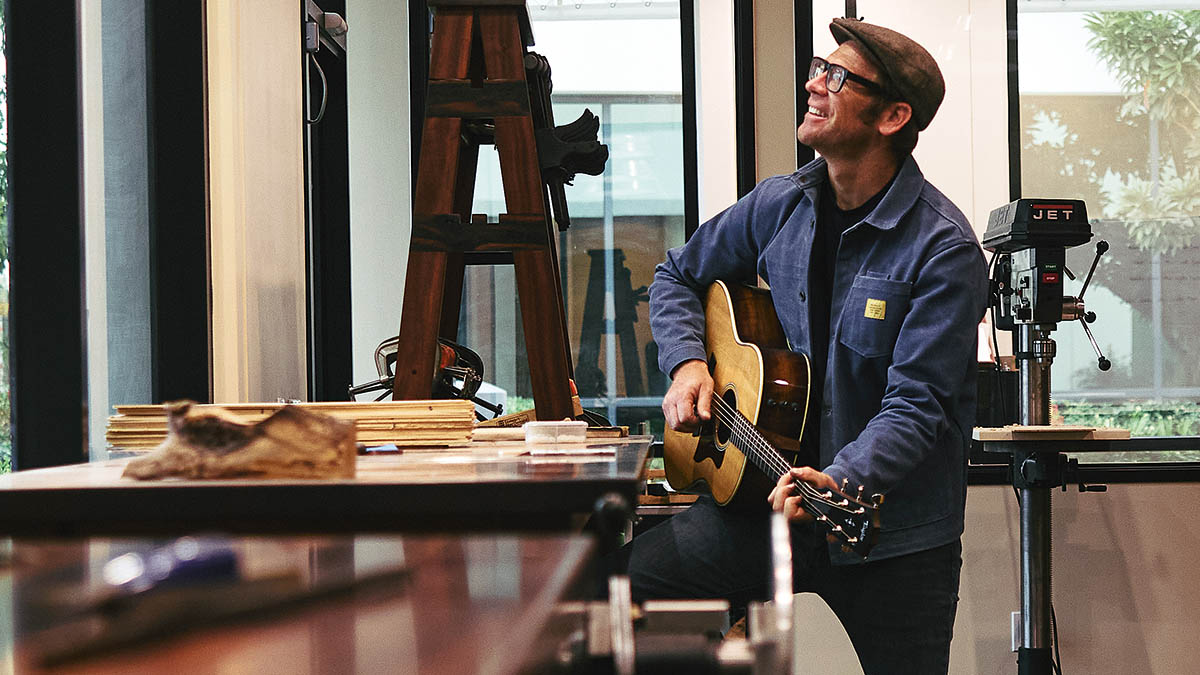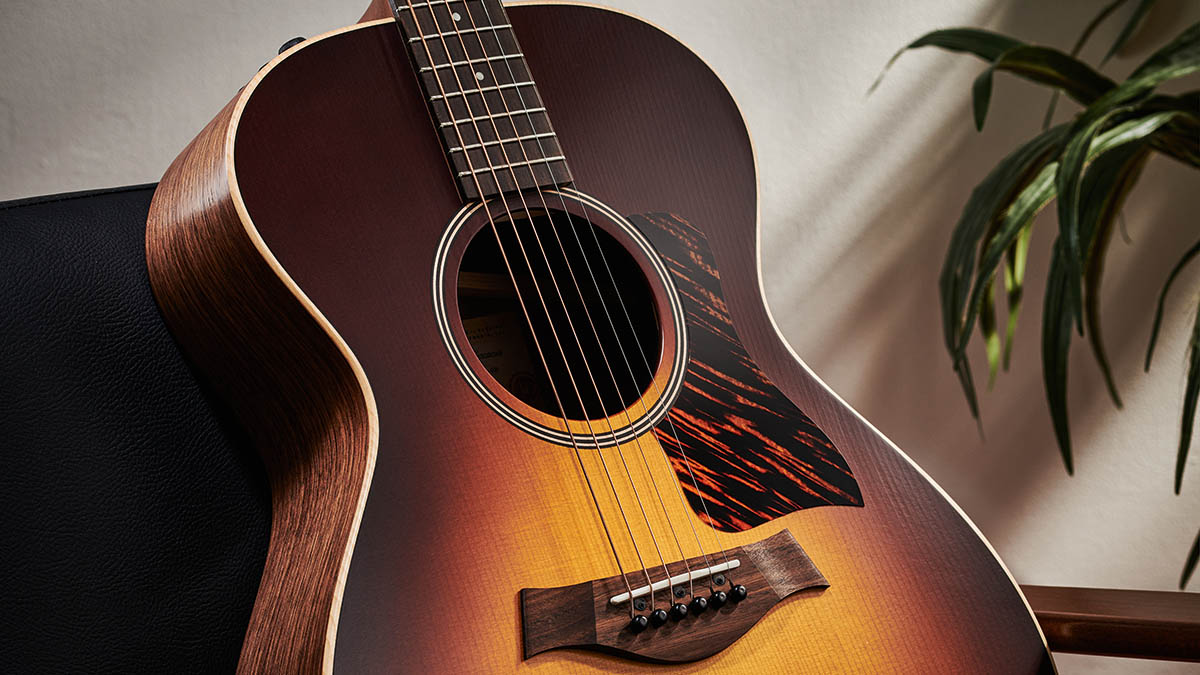
We were very impressed by the Taylor AD12e. And this is something that we share with Andy: “You know, it feels almost like I want to tell a secret or something,” he confides, “but I really like it, too! For what that guitar costs, the amount of musical instrument that you get is really good.”
We couldn’t agree more. It’s an acoustic guitar that works on so many levels. But we’re curious to know about the choice of timbers used in the guitar and how the American Dream Series fits into Taylor’s catalogue.
What’s the ethos behind the American Dream Series as a whole?
“It was actually born out of the pandemic. I looked around and went, ‘Okay, if I don’t have anything that I want, I don’t have the materials that come in from all over the globe, I have hardly anything in a time of uncertainty. What do I really need? What are the essentials? This isn’t a time for filigree and frills and elaborate aesthetics, this is a time to just focus on the basics – let’s get the job done. What’s the job? The job is to make a great-playing instrument, a great-sounding instrument that delivers for a musician.’
“Right? That’s why I describe it as your cup of black coffee. This is gonna get you up and going. And it’s not fancier than that. We would go through our warehouse until we found orphaned wood. What is that wood? It is material that didn’t make the ultra‑high aesthetic standards that we would use in a specific series.
“But we’d see these other materials that are perfectly functional for building great instruments, but maybe they didn’t fit within a certain criteria visually. Okay, well, I can still build a guitar out of that. And it’s going to be a great functioning guitar long after I’m dead and gone. Okay, that’s a great thing to do. Let’s do it. And so that’s how it started.”

Were you surprised by how well the American Dream Series guitars were received by players?
“Yes, we found that musicians responded so well to the spartan appointments – the minimalism of the guitars – that it provided its own inspiration. And so, in a way, it was almost like they weren’t distracted by the ornamentation of the guitar, or the precious materials that it was made from, or anything like that.
“They were inspired by the simplicity of the design and the simplicity of the construction method. At the same time, they were inspired by the dynamic character of the voice. So once things started to get back in motion for us, we realised that it might have been a guitar that we made for the era, but it’s certainly not a guitar we wanted to give up.
“So once I set about sourcing material specifically for these guitars, I thought, ‘Well, what do I want to do? What would be the right character for this guitar?’ So its position has kind of evolved from the time that I first thought of it, to what it’s turned into. Now, there’s just a little more room for some ornamentation. We’re doing this beautiful sunburst finish [on the AD11, 12 and 17] that I love. I love the character of the guitar, I love the way it looks, I love the way it makes me feel.”

If we can look at the individual components of these guitars in terms of their body woods, why did you choose walnut for the backs and sides?
“It’s a tonewood that I’ve always loved. But typically, when we use it, we’re going to look for the one per cent or less that has an ultra-dramatic figure and colour in it. Because that’s the presentation-grade version of that material. A lot of times, that’s what guitar makers would assume is most appropriate for a guitar.
“But the reality is, if I want to talk about dependable, reliable and a great-performing tonewood, man, that’s it. That stuff sounds awesome, functions really well, sounds really great and it behaves well when you build the guitar. So we started going, ‘Well, here’s a widespread domestic wood that looks great, sounds great and is going to serve a musician very, very well.’”
Walnut reminds me of mahogany in that it becomes sweeter sounding, the older it becomes
How does walnut age sonically, in your experience?
“If we need a reference point, it reminds me of mahogany in that it becomes sweeter sounding, the older it becomes. At the same time, it has this dry character but maybe with a little more of the sparkle of koa.
“The walnut shares some of that and, because it is a little more dense than a piece of mahogany typically is, you hear a little more midrange, but it behaves almost equally in the whole frequency spectrum. But there’s a little more of a bell-like character when you strike the note and so you get a little more high-fidelity sound out of it.”
What about using eucalyptus as a fingerboard material?
“This particular eucalyptus is actually a farmed material, raised specifically for woodworking purposes, coming out of Spain and Portugal. Then it’s what they call ‘fumed’. So you’re using this unique kiln and ammonia processing treatment to deliberately react with the tannic acid that’s native in a piece of wood that turns it this beautiful dark colour. And so you end up with a piece of material that has a deep colour that never wears off, looks appropriate for our guitars, has an almost rosewood-ish character, ages gracefully and sounds great.”
And of course, Sitka spruce is an ‘old faithful’, for the top…
“It sounds great, it works great and we love it for good reason. One of the other unique things with these guitars is that we’re finishing them with this ultra‑thin, water-based, very environmentally friendly finish. But it has the thickness and film characteristic almost like an aged lacquer finish. If you can feel the texture of a piece of wood, it’s just barely there. And so it’s unique in that it doesn’t introduce a very high damping factor to this guitar.
“What you feel is this dynamic, very touch-sensitive character, a bit reminiscent of an old guitar in the way it behaves. It’s not maybe quite as durable as, say, our super-high-gloss finishes. This is a little more delicate than that. But I love the character that these guitars develop after a musician has been playing them for a while. To me, as a guitar player, it lights me up. It totally does it for me.”







